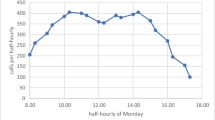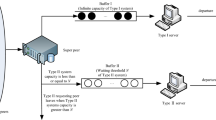Abstract
This paper proposes a queue-aware resource allocation algorithm which provides quality of service (QoS) guarantees. The proposed solution adopts a cross-layer design approach since it is aware of both users’ queue buffer states (data link layer) and channel quality state (physical layer). Main advantages of the proposed resource allocation algorithm are: the low computational complexity and its capacity of maintaining lower QoS violation probability than other multi-cellular schemes. The proposed solution can also result in enhanced cell-edge data rate and improved fairness performance. User minimum data rate and target bit error rate as considered as QoS parameters. Validation of the proposed algorithm is achieved through various simulation scenarios wherein QoS violation probability, system fairness, user average data rate and cell-edge throughput are investigated. Numerical results and complexity analysis demonstrate the efficiency and the feasibility of the proposed QoS-oriented approach.








Similar content being viewed by others
References
E-UTRA and E-UTRAN overall description; stage 2 (release 8). 3GPP technical specification TS 36.300 V8.7.0, December 2008 (Online). Available: http://www.3gpp.org.
Mobile WiMAX-part I: A tecnical overview and, performance evaluation, August 2006.
Tse, D., & Viswanath, P. Fundamentals of wireless communication. Cambridge: Cambridge University Press.
Jang, J., & Lee, K. B. (2003). Transmit power adaptation for multiuser OFDM systems. IEEE Journal on Selected Areas in Communications, 21(2), 171–178.
Li, G., & Liu, H. (2005). On the optimality of the OFDMA network. IEEE Communications Letters, 9, 438–440.
Li, G., & Liu, H. (2006). Downlink resource allocation for multi-cell OFDMA system. IEEE Transactions on Wireless Communications, 5(12), 3451–3459.
Soft frequency reuse scheme for UTRAN LTE. 3GPP project document R1–050 507, May 2005 (online). Available: http://www.3gpp.org.
OFDMA downlink intercell interference mitigation. 3GPP project document R1–060 291, February 2006 (Online). Available: http://www.3gpp.org.
Rahman, M., & Yanikomeroglu, H. (2010). Enhancing cell-edge performance: A downlink dynamic interference avoidance scheme with inter-cell coordination. IEEE Transactions on Wireless Communications, 9(4), 1414–1425.
Fraimis, I. G., Papoutsis, V. D., & Kotsopoulos, S. A. (2010). A decentralized subchannel allocation scheme with inter-cell interference coordination (ICIC) for multi-cell OFDMA systems. In Proceedings of the IEEE global communications conference (Globecom).
Quek, T. Q. S., Lei, Z., & Sun, S. (2009). Adaptive interference coordination in multi-cell OFDMA systems. In Proceedings of the IEEE 20th international symposium on personal, indoor and mobile radio communications (PIMRC).
Ali, S. H., & Leung, V. C. M. (2009). Dynamic frequency allocation in fractional frequency reused OFDMA networks. IEEE Transactions on Wireless Communications, 8(8), 4286–4295.
Chandrasekhar, V., Andrews, J. G., & Gatherer, A. (2008). Femtocells networks: A survey. IEEE Communications Magazine, 56–59.
Kim, H., & Han, Y. (2005). A proportional fair scheduling for multicrrier transmission systems. IEEE Communications Letters, 9(3), 201–212.
Liu, E., & Leung, K. (2010). Expected throughput of the proportional fair Scheduling over Rayleigh fading channels. IEEE Communications Letters, 14(6), 515–517.
Jakes, Jr. W. C. Microwave mobile communications. A Wiley-Interscience publication. New York, Chichester, Brisbane, Toronto: Wiley.
Dahlman, E., Ekstrom, H., Furuskar, A., Jading, Y., Karlsson, J., Lundevall, M., et al. (2006). The 3G long-term evolution-radio interface concepts and performance evaluation. In Proceedings of IEEE vehicular technnology conference (VTC).
Jain, R., Chiu, D. M., & Hawe, W. (1984). A quantitave measure of fairness and discriminaton for resource allocation in shared systems. DEC, research report TR-301.
Ramadas, K., & Jain, R. (2007). Mobile WiMAX part I: A technical overview and performance evaluation. WiMAX Forum. http://www.wimaxforum.org/technology/downloads/.
Author information
Authors and Affiliations
Corresponding author
Rights and permissions
About this article
Cite this article
Fraimis, I.G., Kotsopoulos, S.A. Queue-Aware Resource Allocation for Multi-cell OFDMA Systems with QoS Provisioning. Wireless Pers Commun 71, 3033–3044 (2013). https://doi.org/10.1007/s11277-012-0988-5
Published:
Issue Date:
DOI: https://doi.org/10.1007/s11277-012-0988-5




